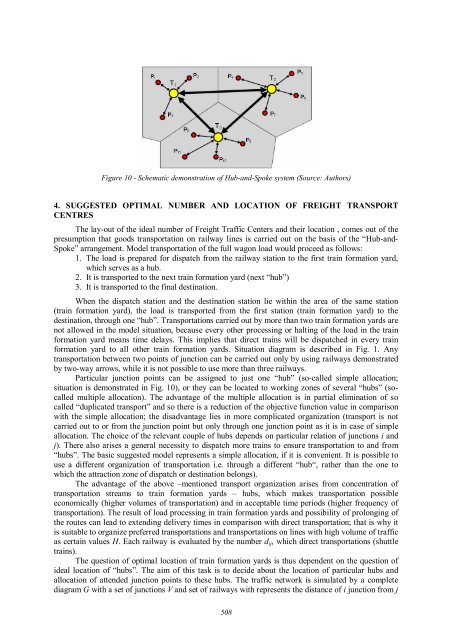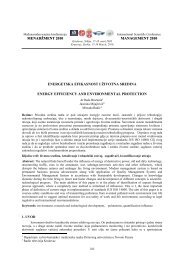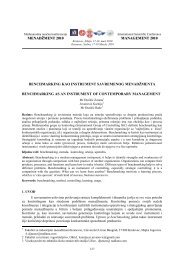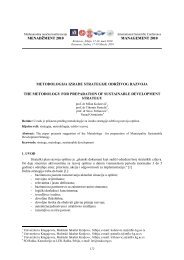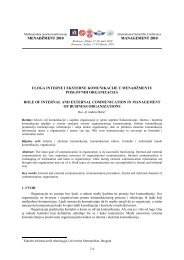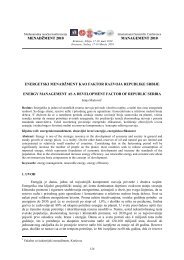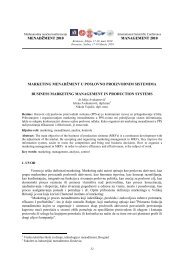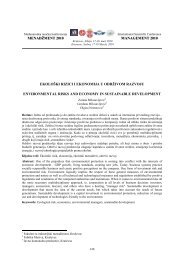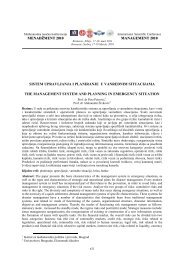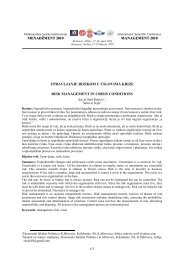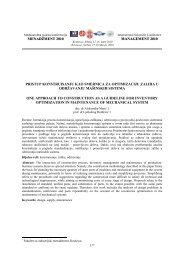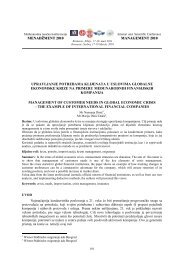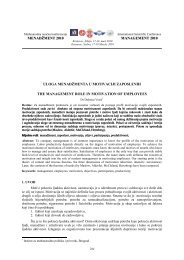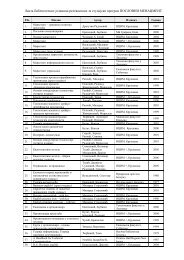intermodal transportation of iso containers and its implementation to ...
intermodal transportation of iso containers and its implementation to ...
intermodal transportation of iso containers and its implementation to ...
Create successful ePaper yourself
Turn your PDF publications into a flip-book with our unique Google optimized e-Paper software.
Figure 10 - Schematic demonstration <strong>of</strong> Hub-<strong>and</strong>-Spoke system (Source: Authors)<br />
4. SUGGESTED OPTIMAL NUMBER AND LOCATION OF FREIGHT TRANSPORT<br />
CENTRES<br />
The lay-out <strong>of</strong> the ideal number <strong>of</strong> Freight Traffic Centers <strong>and</strong> their location , comes out <strong>of</strong> the<br />
presumption that goods <strong>transportation</strong> on railway lines is carried out on the basis <strong>of</strong> the “Hub-<strong>and</strong>-<br />
Spoke” arrangement. Model <strong>transportation</strong> <strong>of</strong> the full wagon load would proceed as follows:<br />
1. The load is prepared for dispatch from the railway station <strong>to</strong> the first train formation yard,<br />
which serves as a hub.<br />
2. It is transported <strong>to</strong> the next train formation yard (next “hub”)<br />
3. It is transported <strong>to</strong> the final destination.<br />
When the dispatch station <strong>and</strong> the destination station lie within the area <strong>of</strong> the same station<br />
(train formation yard), the load is transported from the first station (train formation yard) <strong>to</strong> the<br />
destination, through one “hub”. Transportations carried out by more than two train formation yards are<br />
not allowed in the model situation, because every other processing or halting <strong>of</strong> the load in the train<br />
formation yard means time delays. This implies that direct trains will be dispatched in every train<br />
formation yard <strong>to</strong> all other train formation yards. Situation diagram is described in Fig. 1. Any<br />
<strong>transportation</strong> between two points <strong>of</strong> junction can be carried out only by using railways demonstrated<br />
by two-way arrows, while it is not possible <strong>to</strong> use more than three railways.<br />
Particular junction points can be assigned <strong>to</strong> just one “hub” (so-called simple allocation;<br />
situation is demonstrated in Fig. 10), or they can be located <strong>to</strong> working zones <strong>of</strong> several “hubs” (socalled<br />
multiple allocation). The advantage <strong>of</strong> the multiple allocation is in partial elimination <strong>of</strong> so<br />
called “duplicated transport” <strong>and</strong> so there is a reduction <strong>of</strong> the objective function value in compar<strong>iso</strong>n<br />
with the simple allocation; the disadvantage lies in more complicated organization (transport is not<br />
carried out <strong>to</strong> or from the junction point but only through one junction point as it is in case <strong>of</strong> simple<br />
allocation. The choice <strong>of</strong> the relevant couple <strong>of</strong> hubs depends on particular relation <strong>of</strong> junctions i <strong>and</strong><br />
j). There also arises a general necessity <strong>to</strong> dispatch more trains <strong>to</strong> ensure <strong>transportation</strong> <strong>to</strong> <strong>and</strong> from<br />
“hubs”. The basic suggested model represents a simple allocation, if it is convenient. It is possible <strong>to</strong><br />
use a different organization <strong>of</strong> <strong>transportation</strong> i.e. through a different “hub“, rather than the one <strong>to</strong><br />
which the attraction zone <strong>of</strong> dispatch or destination belongs).<br />
The advantage <strong>of</strong> the above –mentioned transport organization arises from concentration <strong>of</strong><br />
<strong>transportation</strong> streams <strong>to</strong> train formation yards – hubs, which makes <strong>transportation</strong> possible<br />
economically (higher volumes <strong>of</strong> <strong>transportation</strong>) <strong>and</strong> in acceptable time periods (higher frequency <strong>of</strong><br />
<strong>transportation</strong>). The result <strong>of</strong> load processing in train formation yards <strong>and</strong> possibility <strong>of</strong> prolonging <strong>of</strong><br />
the routes can lead <strong>to</strong> extending delivery times in compar<strong>iso</strong>n with direct <strong>transportation</strong>; that is why it<br />
is suitable <strong>to</strong> organize preferred <strong>transportation</strong>s <strong>and</strong> <strong>transportation</strong>s on lines with high volume <strong>of</strong> traffic<br />
as certain values H. Each railway is evaluated by the number d ij , which direct <strong>transportation</strong>s (shuttle<br />
trains).<br />
The question <strong>of</strong> optimal location <strong>of</strong> train formation yards is thus dependent on the question <strong>of</strong><br />
ideal location <strong>of</strong> “hubs”. The aim <strong>of</strong> this task is <strong>to</strong> decide about the location <strong>of</strong> particular hubs <strong>and</strong><br />
allocation <strong>of</strong> attended junction points <strong>to</strong> these hubs. The traffic network is simulated by a complete<br />
diagram G with a set <strong>of</strong> junctions V <strong>and</strong> set <strong>of</strong> railways with represents the distance <strong>of</strong> i junction from j<br />
508


